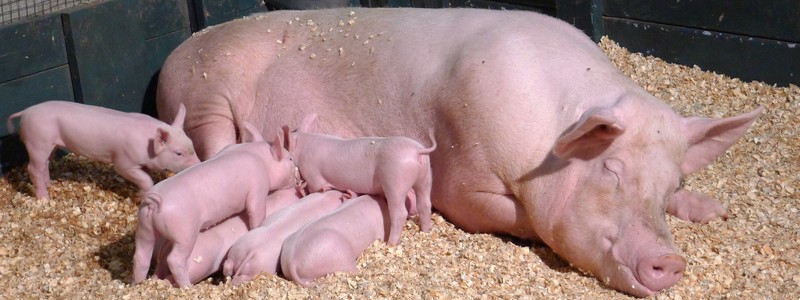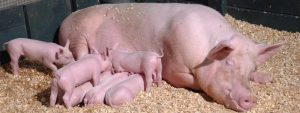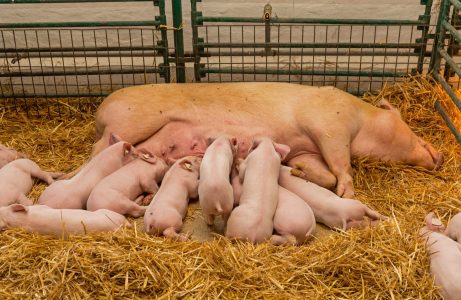 19 Apr 2022
19 Apr 2022
Fatty acid feeding and its effects on sows’ milk. Fatty acids present in sow’s diets have been shown to have the capacity of being transferred to piglets through colostrum and milk.
Research interests in swine nutrition currently focus on gastrointestinal functionality and optimal immune function. With a special focus on the post-weaning period, in which a high intake of antibiotics is used to prevent enteric diseases.
Most of the dietary fatty acids (FA) are bound to triglycerides (TG), which is quantitatively the most important lipid fraction in the pigs’ diet. Contributing more than 95% of the fat within the diet. In addition, dietary fat consists of phospholipids (PL), commonly present as lecithin, and lower contents of cholesterol, cholesterol esters, and fat-soluble vitamins (Read also “Vitamin E: Effect on immunity and fertility in pigs”).

Lipid digestibility
Digestion of dietary lipids begins with an emulsification in the stomach where a partial degradation of TGs takes place. However, the main digestion results from hydrolysis with pancreatic lipase. The lipid emulsion enters the small intestine as fine lipid droplets where the combined action of bile and pancreatic juice produce a significant change in the chemical and physical form of the ingested lipid emulsion.
Under normal conditions for the pig’s intestinal function, digestion and absorption of TG’s are very efficient.
![]()
However, stress related to weaning and preterm birth can compromise the intestine’s functional capacity for digestion, absorption and metabolism of dietary lipids .
Although lipid digestibility in lactating piglets is high (96%), it decreases after weaning (Cera et al., 1988). This is probably due to gastric lipase, which is responsible for the hydrolysis of 10 to 30% of dietary TGs.
When considering lipid sources for the development of milk formulas for piglets or special diets for premature or low birth weight piglets, the impact of TG structure can be evaluated in terms of lipid digestibility. [register]
The composition of FAs, as well as positional distribution in TGs, affect digestion, absorption, and metabolism. These factors also cause an impact on the transfer of various FAs to piglets.

Sow’s milk as a source of lipids
The contribution of lipids through colostrum and milk is an important source of energy for the newborn piglet. Lipid nutrition is important for pig growth and development. In addition to this, FAs are:
Regardless of genetic changes (e.g., development of hyperprolific sows), only minor changes in the macronutrient content of colostrum and milk of sows have appeared in the past 30 years. Resulting in an increase from 6.5% to 7.5% for the total lipid content (from the 1980s to the 2010s) (Zhang et al. , 2018).
The FAs found in colostrum and sow milk are commonly long-chain fatty acids (LCFA) (C14:0, C16:0, C16:1, C18:0, C18:1, C18:2).
The fatty acid composition of sow milk is greatly influenced by the FA composition of the diet (Lauridsen and Danielsen, 2004).
![]()
In addition, the inclusion of dietary lipids in lactation diets influenced the FA profile of progeny tissues during lactation and, this effect in fact was maintained on FA composition during the post-weaning period (Lauridsen and Jensen, 2007).
Coconut oil supplementation (8%) in lactation diets increased the C12:0 ratio (with an increase of 0.5% to 1.3% per unit) in the adipose tissue of piglets during lactation and after weaning (Lauridsen and Jensen, 2007).
![]() This same experiment, led to a trend for improving litter weight gain when lactating sows were fed coconut oil instead of fish oil (Lauridsen and Danielsen, 2004). In addition to this, oral supplementation of coconut oil in underweight piglets tended to increase body weight during the first week (Manzke et al., 2018).
This same experiment, led to a trend for improving litter weight gain when lactating sows were fed coconut oil instead of fish oil (Lauridsen and Danielsen, 2004). In addition to this, oral supplementation of coconut oil in underweight piglets tended to increase body weight during the first week (Manzke et al., 2018).
In a more recent study by Jin et al. (2017), the inclusion of soybean oil and fish oil (around 3 to 4 %) in sows’ diets during the last stage of gestation and lactation improved lactating piglets’ growth performance by increasing milk fat intake (compared to fat-free piglets).
Conclusion
It is possible to transfer fatty acids to the piglet through the sow’s feeding. Efficiency in fatty acid transfer can be improved through different nutritional tools.
While triglycerides composed of short- and medium-chain fatty acids may benefit the growth of piglets due to their immediate absorption into the blood, early nutrition with LCFA can affect the FAs composition of intestinal tissues and cell membrane.
Source: Lauridsen, 2020
[/register]
Subscribe now to the technical magazine of animal nutrition
AUTHORS

Nutritional Interventions to Improve Fertility in Male Broiler Breeders
Edgar O. Oviedo Rondón
The Use of Organic Acids in Poultry: A Natural Path to Health and Productivity
M. Naeem
Synergistic Benefits of Prebiotics and Probiotics in Poultry, Swine, and Cattle
Gustavo Adolfo Quintana-Ospina
Hybrid Rye Potential in Laying Hen Feed Rations
Gwendolyn Jones
A day in the life of phosphorus in pigs: Part I
Rafael Duran Giménez-Rico
Use of enzymes in diets for ruminants
Braulio de la Calle Campos
Minerals and Hoof Health in the Pregnant Sow
Juan Gabriel Espino
Impact of Oxidized Fats on Swine Reproduction and Offspring
Maria Alejandra Perez Alvarado